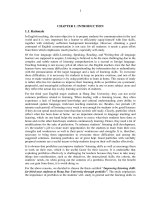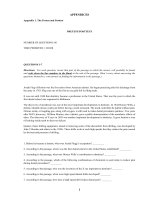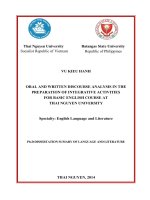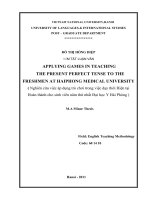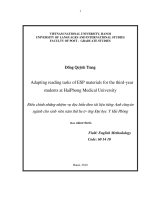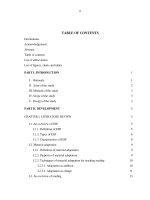Adapting reading tasks of ESP materials for the third-year students at Haiphong Medical University
Bạn đang xem bản rút gọn của tài liệu. Xem và tải ngay bản đầy đủ của tài liệu tại đây (360.04 KB, 12 trang )
Adapting reading tasks of ESP materials for
the third-year students at Haiphong Medical
University
Đồng Quỳnh Trang
Trường Đại học Ngoại Ngữ
Luận văn ThS. Chuyên ngành: English Linguistics; Mã số: 60 22 15
Người hướng dẫn: Nguyễn Bàng, M.A
Năm bảo vệ: 2010
Abstract: Many teachers of English as a foreign language have recognized the importance of
material adaptation. In reality, a textbook can never totally be an effective tool for teachers to
follow without any adaptation because of its intrinsic deficiencies such as linguistic
inaccuracies, out-of-datedness, lack of authenticity or lack of variety. Adaptation is to
compensate for those deficiencies.
The thesis “Adapting reading tasks of ESP materials for the third-year students at
Haiphong Medical University” was carried out in an attempt to investigate into the
evaluation and attitudes of the third-year students and teachers at Haiphong Medical
University towards the current ESP reading tasks used in here for the third-year students. It
also aimed to find out the suitable techniques of adapting ESP reading tasks in order to make
ESP reading lessons more effective, interesting and motivating to the students.
The data of the study was collected from the survey questionnaires for both the teachers and
the students, and the notes from class observation. The findings indicated that there were a
number of factors that the teachers should take into consideration when adapting reading
tasks of ESP materials such as the difficult level, the students’ needed topics, the kinds of
activities, etc. Basing on these factors, some suitable techniques of adapting materials are
suggested.
Keywords: Tiếng Anh chuyên ngành; Đại học Y Hải Phòng; Kỹ năng đọc.
6
Content:
Table of Contents
Declarations
Acknowledgement
Abstract
Table of contents
List of abbreviation
List of figures, charts and tables
Part I. Introduction 1
I. Rationale 1
II. Aims of the study 2
III. Methods of the study 3
IV. Scope of the study 3
V. Design of the study 3
Part II. Development 5
Chapter I. Literature review 5
I.1. An overview of ESP 5
I.1.1. Definition of ESP 5
I.1.2. Types of ESP 6
I.1.3. Characteristics of ESP 8
I.2. Material adaptation 9
I.2.1. Definition of material adaptation 9
I.2.2. Purposes of material adaptation 9
I.2.3. Techniques of material adaptation for teaching reading 10
I.2.3.1. Adaptation as addition 10
I.2.3.2. Adaptation as change 11
7
I.3. An overview of reading 13
I.3.1. Definition of reading and reading comprehension 13
I.3.2. Classification of reading 14
I.3.2.1. According to manner 15
I.3.2.1.1. Reading aloud 15
I.3.2.1.2. Silent reading 15
I.3.2.2. According to purposes 16
I.3.2.2.1. Skimming 16
I.3.2.2.2. Scanning 16
I.3.2.2.3. Intensive reading 16
I.3.2.2.4. Extensive reading 17
I.4. Concluding remarks 17
Chapter II. The study 18
II.1. Situational analysis 18
II.1.1. ESP teaching and learning situation at HPMU 18
II.1.2. The material description 18
II.1.3. The course objective 19
II.2. Research methodology 20
II.2.1. Subjects of the study 20
II.2.1.1. The teachers 20
II.2.1.2. The students 20
II.2.2. Data collection instrument 21
II.2.2.1. Questionnaires 21
II.2.2.2. Follow-up class observation 21
II.3. Procedures 22
II.4. Data analysis 23
II.4.1. Questionnaires 23
II.4.1.1. Evaluation of the effectiveness of reading tasks in the ESP materials 23
8
II.4.1.2. The attitudes and evaluation of the reading texts in the current
textbook 24
II.4.1.3. Needed topics perceived by the students 26
II.4.1.4. Students’ attitudes towards pre-reading activities 26
II.4.1.4.1. The frequency of using extra pre-reading activities
designed by the teachers (responded by the students) 26
II.4.1.4.2. Students’ attitudes towards given pre-reading activities 27
II.4.1.5. The post-reading activities used by the teachers 28
II.4.1.6. The necessity of adapting the reading tasks in the ESP materials 29
II.4.1.7. The students’ and teachers’ difficulties in learning and teaching
medical reading (respectively) 30
II.4.1.8. The students’ expectations from the teachers and reading
activities employed by the teachers to help their students
overcome difficulties 31
II.4.2. Follow-up class observation 32
II.5. Concluding remarks 33
Chapter III. some suggested techniques of adapting reading
tasks for the third-year students at hai phong
medical university 34
III.1. Replacing 34
III.2. Supplementing 35
III.3. Extending 38
Part III. Conclusion 40
1. Summary of the study 40
2. Limitations of the study 41
3. Suggestions for further study 41
9
References
Appendices
Abbreviations
HPMU
Haiphong Medical University
ESP
English for Specific Purposes
ELT
English Language Teaching
EOP
English for Occupational Purposes
EAP
English for Academic Purposes
EST
English for Science and Technology
EBE
English for Business and Economics
ESS
English for Social Studies
10
List of tables and charts
Chart 1. Evaluation of the effectiveness of reading tasks in the ESP materials
Chart 2. The frequency of using extra pre-reading activities designed by the teachers
Chart 3. The necessity of adapting the reading tasks in the ESP materials
Table 1. The attitudes and evaluation of the reading texts in the current textbook
Table 2. Needed topics perceived by the students
Table 3. Students’ attitude towards given pre-reading activities
Table 4. The post-reading activities used by the teachers
Table 5. Students and teachers difficulties in learning and teaching medical reading
(respectively)
Table 6. The students’ expectations from their teachers and reading activities employed by the
teachers to help their students overcome difficulties
11
Part I. Introduction
I. Rationale
Nowadays English has gained its great popularity all over the world, and this is not an
exception in Vietnam. Our country has now been in the process of regional and global
integration, which has brought about a great many arrivals of foreign visitors, especially since
the implementation of the open-door policy. This makes English the commonest language of
communication which is widely used in all aspects of life. Thus, the demands for using
English as a means of communication make the English teaching and learning more and more
necessary. This is realized by the teaching of this language at almost all universities in
Vietnam, and unexceptionally at Haiphong Medical University (HPMU).
To meet the increasing needs for using English as a means of international communication,
English has been made a compulsory subject in the curriculum of HPMU. It is taught with the
purpose that the students will use it effectively to fulfill their daily work in the future, so it
receives great deal concern of both teachers and students here. Non-stop attempts have been
made to provide the students with general English as well as English for Specific Purposes
(ESP).
ESP is now established chiefly in the universities and the teaching of adults outside the
state school system. The main objective of ESP course is aimed at providing the students with
linguistic knowledge relevant to their field and skills up to their expectation of their future
employment. However, students learning ESP in Vietnam rarely have opportunities to use
English in communication outside the classroom. They mainly have access to popular
documents written in English through reading. Hence, skills in reading English texts are
naturally of special importance in teaching and learning ESP, which is not an exception for the
ESP teaching at HPMU. HPMU is one of those where ESP involves within an English
teaching situation in response to the demand for specific language skills for the specialists –
12
the graduated doctors. Therefore, improving students’ reading skills is recognized as a
principal objective of ESP course provided by teachers of English at HPMU.
Besides, the ESP at HPMU mainly focuses on reading skills and has now been one of the
most stimulating but challenging subject. It is stimulating because, in comparison to general
English, it is more relevant course of the students’ major concern. However, challenges appear
due to the fact that the ‘literary’ teachers are constantly facing the ‘content burden’ problem,
students are still immature in terms of both assumed knowledge and the English language.
Moreover, the material English in Medicine for the third-year students at HPMU is an edited
collection from various sources and is designed with nearly all exercises relating to the texts. It
is lack of realistic and interesting tasks to meet the needs and expectations of the students.
Consequently, adapting ESP reading tasks has become vital for teachers.
In fact, there have been some researches about material adaptation by I an McGrath (2002)
or Tomlinson (1998), etc. However, there have not been any studies dealing with reading task
adaptation, especially for teaching and learning English in a medical university like HPMU.
Nevertheless, it can not be denied that adapting material is a broad field to cover. In the
limit of a minor thesis, I just wish to find out the evaluation and attitudes of the teachers and
the students in the university about the ESP reading materials. This then would be taken as the
basic for my recommendation of the appropriate techniques for adapting ESP reading tasks to
make the lessons more effective and interesting.
With all the above mentioned reasons, ‘Adapting reading tasks of ESP materials for the
third year students at HPMU’ is chosen for the thesis and it also has been an urgent work for
the development of ESP teaching and learning at HPMU.
II. Aims of the study
This thesis has been carried out to:
Investigate into the evaluation and attitudes of the third-year students and teachers
at HPMU towards the current ESP reading tasks used in here for the third-year
students.
13
Find out techniques of adapting ESP reading tasks in order to make ESP reading
lessons more effective, interesting and motivating to students.
In brief, these objectives are summarized into the following research questions:
What are the HPMU teachers and third-year students’ evaluation and attitudes
towards the current ESP reading tasks used by them?
What techniques of adapting materials should be used for teaching ESP reading to
the third-year students at HPMU?
III. Methods of the study
Both qualitative and quantitative methods are employed in this study.
The quantitative method, which is used to collect data by questionnaires, aims at exploring
the needs of the students, their expectations and opinions about the ESP reading tasks. The
questionnaires are administered to the third-year student population studying ESP as well as
the teachers of ESP at HPMU. The tackling methods are statistic, analytical and synthetical.
Also the qualitative method is used in the sense that relevant issues concerning reading and
reading comprehension, ESP materials, and adapting materials etc. are gathered, critical re-
examined, analyzed and synthesized in order to establish the senses in which terms or
concepts in the field are employed. Consulting the supervisor, observing classes and collecting
information for the study through the discussion with colleagues, students of HPMU are also
involved.
IV. Scope of the study
The ESP course is only for the third-year students at HPMU, so the study is only
concerned with the adaptation of ESP reading tasks to the third year students at HPMU.
V. Design of the study
The study is comprised of three parts: Introduction, Development and Conclusion.
Part I is the introduction which presents the rationale, the aims, the scope, the research
methods and the design of the study.
Part II is the development, consisting of three chapters:
14
o Chapter 1 explores the literature for the thesis, relating to ESP, material
adaptation and reading theories.
o Chapter 2 deals with subjects, research methodology, instruments, detail
description of data analysis and a brief discussion of the findings.
o Chapter 3 is devoted to some recommendations on ways of adapting ESP
reading tasks suggested in the form of giving samples.
Part III is the conclusion which offers a summary of the study, limitations and
suggestions for further study.
52
References
1. Carter, D. (1983). “Some Propositions about ESP”, The ESP Journal (2), pp. 131-137.
2. Charles, M. (1992). Nursing in a New Language. Lynx Publishing.
3. Cunningsworth, A. (1984). Evaluating and Selecting EFL Teaching Materials.
London: Heinemann
4. Cunningsworth, A. (1995). Choosing Your Course Book. London: Heinemann
5. Doff, A. (1988). Teaching: A Training Course for Teachers. Cambridge: CUP.
6. Dudley-Evan, T., & St John, M. (1998). Development in ESP: A multi – disciplinary
approach. Cambridge: Cambridge University Press.
7. Glendingning, E. H., & Holmstrom, B. A. (1987). English in Medicine. London:
Heinemann
8. Goodman, K. S. (1971). Reading a Psycholinguistic Guessing Game. In Harry Singer
and Rorbert B. Ruddell (Eds).
9. Greenwood, J. (1985). The Teaching of English as an International Language. Collins:
Glassgrow and London.
10. Grellet, F. (1981). Developing reading skills: A practical guide to reading
comprehension. Cambridge: Cambridge University Press.
11. Harmer, H. (1989). The Practice of English Language Teaching. Harlow: Longman.
12. Hutchinson, T., & Waters, A. (1987). English for specific purposes: A learning centred
approach. Cambridge: Cambridge University Press.
13. Kenedy, C., & Bolitho, R. (1984). English for Specific Purposes. London: Macmilan
Press.
14. Lewis, M., & Hill, J. (1985). Practical Techniques for Language Teaching. London:
Commercial Color Press.
15. McDonough, J., & Shaw, C. (1993). Materials and Methods in ELT. Oxford:
Blackwell.
16. McGrath, I. (2002). Material Evaluation and Design for Language Teaching.
Edinburgh University Press.
53
17. Merki, M. B. (1990). Teen Health. Macmillan: McGrawhill.
18. Norman, R. (1990). Let’s Examine The Texts. University of Canberra.
19. Nunan, D. (1991). Curriculum Development in Language Education. Cambridge:
Cambridge University Press.
20. Nuttall, C. (1982). Teaching reading skills in a foreign language. London: Macmillan
Publishers Ltd.
21. Nuttall, C. (1996). Teaching reading skills in a foreign language. London: Heineman
Educational Books.
22. Rubin, J., & Thompson, I. (1994). How To Be a More Successful Language Learner.
Boston: Heinle & Heinly Publishers.
23. Robinson, P. (1991). ESP Today: A Practitioner’s Guide. New York: Prentice Hall.
24. Rummerhart, D. (1977). Towards an Interactive Model of Reading. In S. Dordic (Eds).
Attention and Performance IV. Academic Press.
25. Swan, M. (1975). Inside Meaning. Cambridge: CUP.
26. Tickoo, M. L. (Ed.). (1988). ESP: State of art. SEAMEO Regional Language Centre.
27. Tomlinson, B. (1998). Materials Development in Language Teaching. Cambridge:
Cambridge University Press.
28. Tomlinson, B. (2003). Developing Materials for Language Teaching. Cambridge:
Cambridge University Press.
29. Tomlinson, B. (2004). Materials Evaluation. Trowbridge Wiltshire: Cromwell Press.
30. Trinh Thi Thuy, Ho Lieu Bieu, Pham Gia Khai, & Nguyen Van Truong. (1990).
English for Medical Student. Centre of Human Resources for Health.
